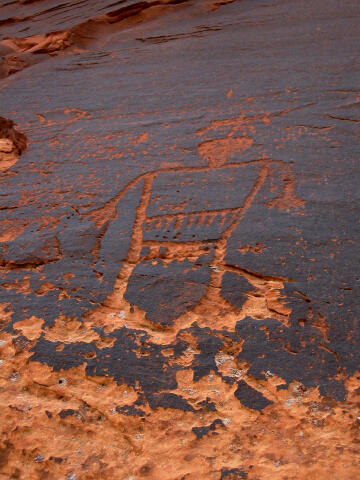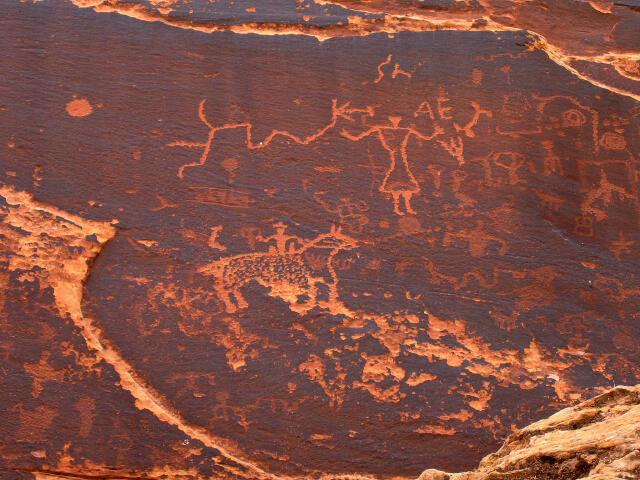The Legend of Kokopelli

- Kokopele
- Kokopelli-mana or Kokopelmana (actually, Kokopelli's wife) (Hohokam)
- Kokopeltiyo
- Kokopilau
- Neopkwai'i (Pueblo)
- Ololowishkya (Zuni)
- Casanova of the Cliff Dwellers
- Water Sprinkler
- Humpbacked Flute Player
- Hunchbacked Flute Player========================
The Anasazi & Kokopelli
Anasazi, which means 'ancient stranger' or 'ancient enemy' in the Navajo language, is the name most commonly applied to the early pueblo dwellers who once lived in the Colorado Plateau or Four Corners Area.
The Hopi who are the likely descendents of the Anasazi called these predecessors the "Hisatsinom" for "The Ones Who Came Before."
Links are difficult to maintain. If you are interested in current web sites on the Anasazi, I suggest that you go to Google and try "Anasazi" as a search term.

 Art History Webpage
Art History Webpage  Photos of Anasazi Structures
Photos of Anasazi Structures  Settlement Chronology
Settlement Chronology  The Disappearance of the Anasazi
The Disappearance of the Anasazi  DesertUSA - Anasazi
DesertUSA - Anasazi  DesertUSA - Prehistoric Desert Peoples
DesertUSA - Prehistoric Desert Peoples  John Kantner's Cyber Presentations on the Anasazi
John Kantner's Cyber Presentations on the Anasazi  Mining Company - Anasazi Pre-History
Mining Company - Anasazi Pre-History  Anasazi Archaeology
Anasazi Archaeology  Integrative Study of Native Culture
Integrative Study of Native Culture  Navajo Nation - Anasazi Ruins
Navajo Nation - Anasazi Ruins  Anasazi - The Ancient People
Anasazi - The Ancient People  Indian Ruins of the Southwest
Indian Ruins of the Southwest  William Calvin: How the Shaman Stole the Moon
William Calvin: How the Shaman Stole the MoonKokopelli (or Kokopilau): The Flute Player
 Kokopelli is a figure commonly found in petroglyphs and pottery throughout the southwest. Since the first petroglyhs were carved around 3,000 years ago, he predates even Oraibi, the oldest continuous settlement in North America.
Kokopelli is a figure commonly found in petroglyphs and pottery throughout the southwest. Since the first petroglyhs were carved around 3,000 years ago, he predates even Oraibi, the oldest continuous settlement in North America. He Is regarded as the universal symbol of fertility for all life, be it crops, hopes, dreams, or love.
Some legends suggest that Kokopelli was an ancient toltec trader who traveled routes between Mexico, the west coast, the southwest, and possibly even as far as the eastern areas of the U.S. Documented finds lend truth to these legends as dentalium shells, which are only found in certain coastal areas, and macaw feathers from Mexico have been unearthed here in northern new mexico and arizona. Kokopelli was said to play a flute as he traveled to pronounce his arrival to the villagers and it was considered the greatest of honors to be the women he chose to be his "dreamtime companion" for his duration of time in the village as many of these women apparently bore children from these unions.
About Kokopelli
Hopi legend tells us that upon their entrance onto this, the fourth world, the Hopi people were met by an Eagle who shot an arrow into the two "mahus," insects which carried the power of heat. They immediately began playing such uplifting melodies on their flutes that they healed their own pierced bodies. The Hopi then began their separate migrations and each "mahu" would scatter seeds of fruits and vegetables onto the barren land. Over them, each played his flute to bring warmth and make the seeds grow. His name -- KOKO for wood and Pilau for hump (which was the bag of seeds he always carried)-- was given to him on this long journey. It is said that he draws that heat from the center of the Earth. He has come down to us as the loving spirit of fertility -- of the Earth and humanity. His invisible presence is felt whenever life come forth from seed -- plants or animals.
A search of the web reveals the extent of the commercialization of the Kokopelli image -- you name it ... jewellry, sculpture, t-shirts, artwork ... and you'll find him . Thus, I suppose he qualifies as one of the universal symbols that Carl Jung talked about.
========================http://climb-utah.com/CM/sandisland.htm
Sand Island
PetroglyphsCedar Mesa
HikingFor a thousand years before the white man came, Indians of the southwest camped on the riverside flat. While here they carved drawings in the rock cliff. This primitive bulletin board contains the dreams, ambitions and fears of people who had no written language. Please protect these drawings so others may see and study them.
General Information:
The Sand Island Petroglyph Panel is a roadside stop. The panel contains several hundred figures. The styles range from Archaic to fairly recent Native American and cowboy inscriptions. The panel can be viewed from your vehicle, but if you truly want to see the detailed figures you need to spend a couple of minutes and walk over to the cliff. The rock art is accessible year in all weather conditions. Please take only pictures and leave only footprints.
A GPS is a complete waste of time but I'll give you the waypoints because I know how much some of you like to push buttons. The USGS 7.5' Map titled "Bluff" shows the area described. Navigation for this route is non-existent. All waypoints and maps use the WGS84 datum.

Trailhead Information:
From Bluff, Utah drive west on Highway 191 a little over 3 miles to mile marker 22 and the signed Sand Island State Park turn off. Turn south into Sand Island State Park and drive 0.3 miles down the road to the signed junction. Turn west (right) and follow the road an additional 0.3 miles to the signed and fenced Sand Island Petroglyphs (N37° 15' 42", W109° 37' 07") located on the north side of the road.Any vehicle can access the petroglyph panel. Camping and picnic sites are available at the State Park for a fee. Sand Island is mainly used for the boat ramp that allows river rafters to access the San Juan River.


No comments:
Post a Comment